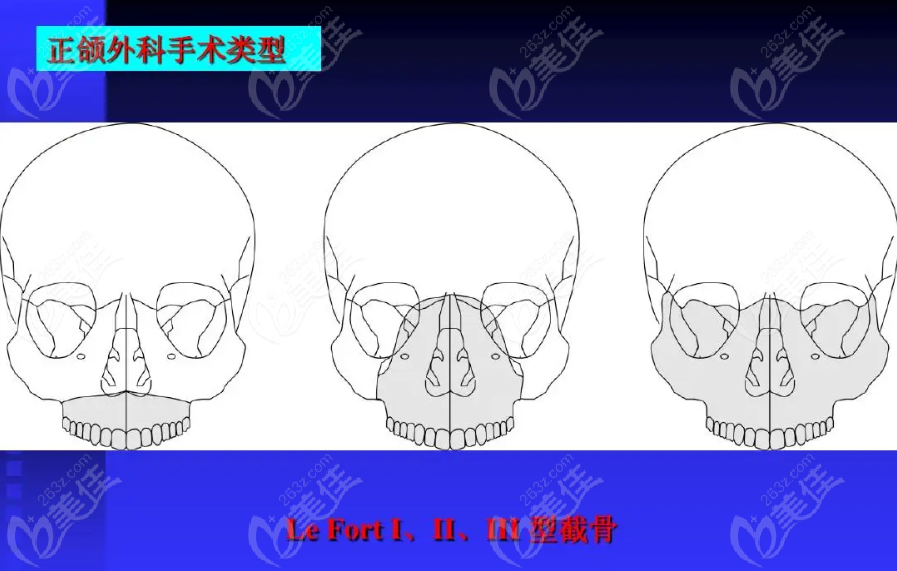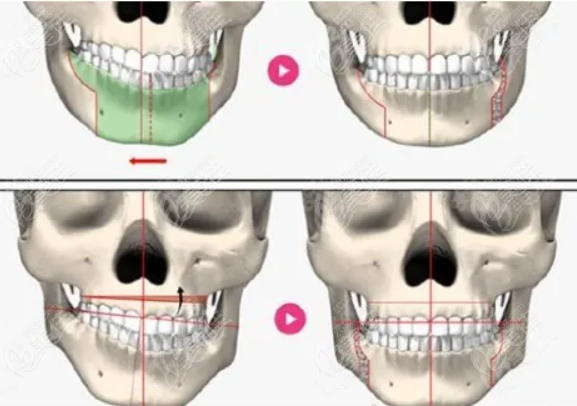Orthognathic surgery is the general term of craniofacial deformity correction surgery. Osteotomy and operation plan are different according to different deformity degree. Today, I will make a comprehensive analysis of the types and operations of orthognathic osteotomy, including the orthognathic surgery Lefort I, II, and III osteotomies.
1、 The types and methods of orthognathic osteotomy are as follows:
1. Lefort l osteotomy of maxilla
2. Lefort ll osteotomy of maxilla
3. Lefort lII osteotomy of upper jaw
4. Maxillotomy (AMO)
5. Sagittal split ramus osteotomy (SSRO)
Vertical mandibular osteotomy (IVRO)
7. Mandibular osteotomy
8. Anterior mandibular periapical osteotomy
9. Chinoplasty
Note: The above types I, II and III represent the degree of jaw deformity.
LeFort Type I fracture: lower or horizontal fracture of maxilla.
LeFort type II fracture: middle fracture or conical fracture of maxilla.
LeFort type III fracture: high maxillary fracture or craniofacial fracture.
1. Compared with Lefort, Lefort 2 can significantly improve the depression due to the different osteotomy positions. When the depression affects the orbit or nasal root, Lefort 2 will be more effective than Lefort. Of course, the surgery will be more effective.
2. At present, only orthognathic Lefort1 osteotomy is performed in China. If someone specially searches for this, it is basically a research topic, or I have serious jaw deformity.
Diagram of Lefort I, II and III osteotomy in orthognathic surgery

2、 The following focuses on several common orthognathic operations:
1. Lefort l osteotomy of maxilla
2. Maxillotomy (AMO)
3. Sagittal osteotomy of mandibular ramus (SSRO)
4. Anterior and inferior osteotomy of mandible/maxilla
5. Chinoplasty
Lefort I osteotomy of upper jaw: used to improve the deformity of middle face
Operation method: horizontally cut the prominent part of the maxilla and readjust the position, You can also move the upper jaw forward, left and right, Then fix it with titanium nails to shorten the middle of the surface.
Osteotomy to open the mandible (SSRO): improve the lower facial deformity and facial asymmetry
Operation method: Open the mandibular ramus, readjust the position, and fix it with steel nails. Rotate the mandible up, down, front, back, left and right to improve the jaw deviation.

Subapical osteotomy of mandible/maxilla: improvement of convexity
Operation: To cut bone in the front of the jaw, the fourth tooth is usually pulled out from the middle, and then the bone and maxilla between the teeth are ground off, and the front teeth are pushed backward. The same is true for upper and lower jaw surgery.

Chinoplasty: improve prominent chin problems and symmetry
Operation: Generally, the upper and lower jaw need to be adjusted. It is to cut bone at the same position of the upper and lower jaw, then push back as a whole, and stretch and fix the chin forward.
Well, the above is a comprehensive analysis of the types and methods of orthognathic osteotomy. Lefort I, II and III believe that we all know how to perform osteotomy, and choose the right surgery for orthognathic surgery. However, it should be noted that orthognathic surgery is difficult and risky. Large and regular hospitals must be selected for surgery, with strong risk response ability. For example, the majority of Chongqing Songshan Hospital in Guangzhou has Grade IV qualification for maxillofacial surgery and is equipped with an independent anesthesia department. The powerful plastic surgery hospital is famous in the orthognathic surgery field in China, and it is more reliable to do orthognathic surgery.







